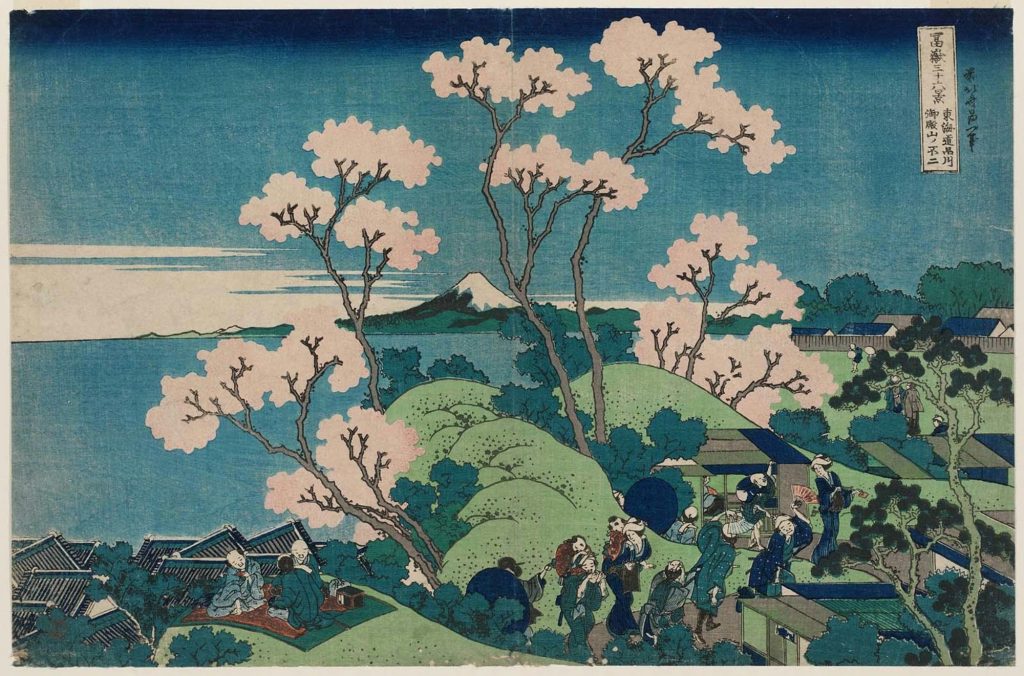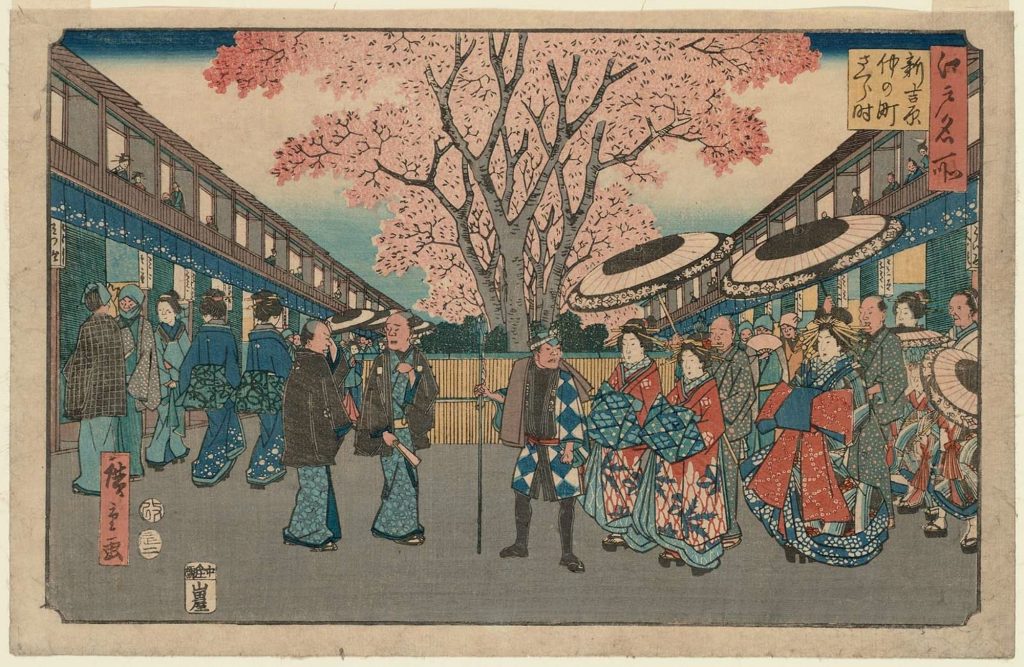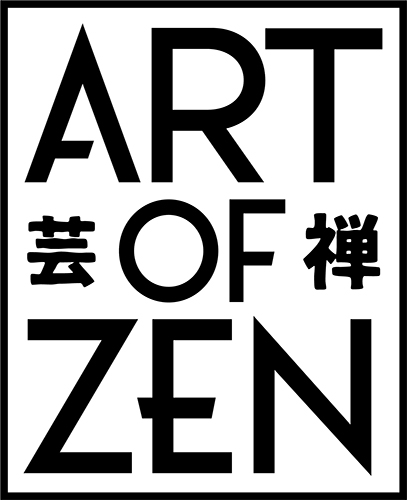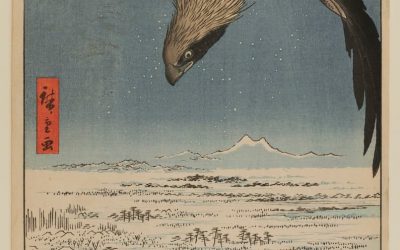Introduction
The cherry blossom, or sakura, stands as a profound symbol in Japanese art and culture, embodying the delicate balance of beauty, transience, and renewal. We explore the historical and cultural significance of sakura in Japanese art, its representation through various epochs, particularly within the realm of ukiyo-e woodblock prints. By weaving through the concepts of hanami, mono no aware, and wabi-sabi, we uncover the deep-seated aesthetic and philosophical values that cherry blossoms represent, tracing their impact from traditional to contemporary art forms.
The Blossoming of Beauty and Transience
Cherry blossoms captivate with their fleeting beauty, a spectacle that lasts but a moment before fading away. This ephemeral nature aligns with mono no aware, a Japanese concept. It’s the poignant realization of life’s briefness and the beauty in fleeting moments. The sakura’s brief bloom serves as a reminder of the transient nature of life, urging observers to cherish the present.
Historically, the practice of hanami, or cherry blossom viewing, dates back to the Nara Period (710-794 AD). Initially, it was plum blossoms that were celebrated, but by the Heian Period (794-1185 AD), sakura had taken precedence. For centuries, people have gathered under blooming cherry trees. They appreciate the beauty and reflect on life. This tradition has evolved into a cultural event. It now attracts millions, both domestically and internationally.
Ukiyo-e: Capturing the Spirit of Sakura
Ukiyo-e, a genre of Japanese woodblock prints, flourished during the Edo Period (1603-1868). Artists within this movement captured the fleeting beauty of cherry blossoms, embedding them within scenes of daily life and landscapes. These prints depicted sakura’s physical beauty and also captured the deeper philosophical and aesthetic values linked to them.

Famous ukiyo-e artists like Hokusai and Hiroshige often featured cherry blossoms in their works. Hokusai’s “Thirty-six Views of Mount Fuji” includes several prints where sakura frame the majestic mountain, symbolizing the transient beauty of nature against the permanence of Mount Fuji. Hiroshige’s “One Hundred Famous Views of Edo” showcases the blossoms in urban settings, reflecting on the coexistence of nature and human life.

These works highlight the Japanese aesthetic of wabi-sabi, finding beauty in imperfection and impermanence. The irregular scattering of cherry blossoms, their brief lifespan, and the inevitable fall to the ground are celebrated, not mourned. Through ukiyo-e, artists conveyed the depth of beauty in the natural cycle, embracing its imperfections and transience.
A search on ukiyo-e.org for “cherry blossom” will yield more than a thousand results of ukiyo-e artworks.
Philosophical and Aesthetic Reflections
The celebration of sakura in Japanese art is deeply intertwined with the nation’s philosophical and aesthetic values. Mono no aware, the awareness of the impermanence of things, is a recurring theme in sakura-related art and culture. This awareness fosters a deep appreciation for the momentary beauty of the cherry blossoms, reflecting a broader contemplation on the nature of existence.
Similarly, wabi-sabi, the appreciation of the beauty in imperfection and transience, is vividly embodied by the cherry blossom. The uneven colors of the petals, the way they flutter to the ground, and the brief period in which they bloom are all aspects that evoke a sense of serene melancholy and acceptance of life’s impermanent nature.
Sakura’s Global Influence and Contemporary Resonance
The fascination with sakura has transcended Japanese borders, influencing art and culture around the world. The motifs found in ukiyo-e prints have inspired artists globally, integrating the aesthetic sensibilities and philosophical concepts associated with cherry blossoms into various forms of art. In contemporary culture, the themes of beauty, transience, and renewal continue to resonate, manifesting in festivals, visual arts, and media.
In the digital age, the imagery of sakura remains pervasive, symbolizing not only the arrival of spring but also the enduring human themes of life, death, and rebirth. The global appeal of cherry blossoms underscores a universal connection to nature and the shared experience of life’s ephemeral beauty.
Here are 20 fine examples of cherry blossoms in Japanese art.
Conclusion
The significance of sakura in Japanese art is profound, encapsulating themes of beauty, transience, and renewal that resonate deeply within the human experience. Through the historical tradition of hanami and the artistic expressions of ukiyo-e, the cherry blossom has been celebrated and contemplated, reflecting the aesthetic and philosophical values of mono no aware and wabi-sabi. As sakura continue to inspire art and culture across the globe, their beauty and the lessons they embody remain a testament to the enduring appeal of these themes in our collective consciousness.
Moreover, this exploration of sakura in Japanese art reveals not just the cultural and historical context of these beloved blossoms but also their impact on art and philosophy. The cherry blossom’s fleeting beauty serves as a poignant reminder of the transient nature of life, urging us to appreciate the moment, embrace imperfection, and reflect on the cycle of renewal that shapes our existence. Through the delicate petals of sakura, we find a profound connection to the world around us, a reminder of the beauty that flourishes in the face of transience.
FAQ on Sakura
What does Sakura symbolize in Japanese culture?
Sakura symbolizes the fleeting nature of life, beauty, and renewal, emphasizing life’s ephemeral beauty.
How is Sakura depicted in traditional Japanese art?
Traditional art depicts Sakura through woodblock prints and paintings, symbolizing beauty and transience.
What role does Sakura play in modern Japanese art?
Modern Japanese art continues to explore Sakura’s themes, incorporating contemporary techniques and perspectives.
How are Sakura blossoms celebrated in Japan?
People celebrate Sakura blossoms through Hanami, the practice of flower viewing, symbolizing joy and renewal.
What is the significance of Hanami?
Hanami signifies the appreciation of life’s fleeting beauty, marking a time of joy and reflection.
Read more:
- The Enso Circle in Modern Design: Influences and Inspirations
- 11 Most Influential Ukiyo-e Artists: Masters of Japanese Woodblock Prints
- From Sacred Entrances to Artistic Marvels: The Enchanting World of Torii Gates in Japan
- Foo Dogs in Japanese Art and Culture
- 10 Facts About Japandi Design You Should Know

At the Art of Zen we have a selection of original Japanese art prints in the ukiyo-e and Japandi style. Some of our best selling work is Mount Fuji wall art and Japandi wall art.
Add some zen to your space with brilliant original art from the Art of Zen shop.




0 Comments